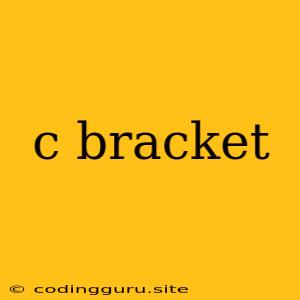What are C Brackets and Why are They So Important?
In the world of programming, especially in languages like C, C++, Java, and many others, you'll encounter a pair of symbols that seem ubiquitous: curly brackets ({}). These are often referred to as C brackets or braces. But why are they so essential? What do they signify, and how do they influence code execution?
The Role of C Brackets in Code Structure
Imagine C brackets as the building blocks of your code. They help create a clear structure and define specific blocks of instructions. Think of them as containers that hold related code together.
Here's a breakdown of their key functions:
- Defining Blocks: C brackets are used to define code blocks. For example, in a function, the code within the C brackets is the function's body, specifying the actions to be performed.
- Scope Control: C brackets determine the scope of variables. Variables declared within a block are only accessible within that block. This helps prevent accidental modification and ensures code clarity.
- Conditional Execution: In control flow statements like
if,else, andfor, C brackets define the code to be executed under specific conditions. - Creating Structures and Classes: In languages like C++ and Java, C brackets are used to define classes and structures, which encapsulate data and functions together.
C Brackets in Action: Examples
1. Function Definition:
int sum(int a, int b) { // Function definition with C brackets
int result = a + b;
return result;
}
In this example, the C brackets define the code that performs the addition and returns the sum.
2. Conditional Execution:
if (age > 18) { // Code block with C brackets for an 'if' statement
System.out.println("You are an adult.");
} else { // Another code block for 'else'
System.out.println("You are not an adult yet.");
}
Here, the C brackets enclose the code that executes based on the condition (age > 18).
3. Loops:
for (int i = 0; i < 5; i++) { // Code block within a 'for' loop
print(i);
}
The C brackets in this example contain the code that gets executed repeatedly within the loop.
C Brackets and Code Readability
C brackets are crucial for maintaining code readability and organization. By clearly defining code blocks, they help:
- Structure: Code becomes easier to understand and navigate due to clear block structures.
- Maintenance: Changes and bug fixing become simpler as code is modularized using C brackets.
- Collaboration: Multiple developers can work on different parts of the code without confusion.
Common Errors and Best Practices
While essential, C brackets can also be a source of errors if not used correctly. Here are some common mistakes and best practices to avoid them:
- Mismatched Brackets: Every opening bracket must have a corresponding closing bracket. Mismatches cause syntax errors.
- Indentation: Use consistent indentation within C brackets to improve readability.
- Empty Blocks: While valid, empty code blocks can be confusing. Add a comment or a placeholder statement to indicate an intentional empty block.
Conclusion
C brackets, also known as curly brackets, play a crucial role in structuring and organizing code. They define blocks, control variable scope, enable conditional execution, and form the foundation for code readability and maintainability. By understanding their function and following best practices, you can write clearer, more efficient code.
